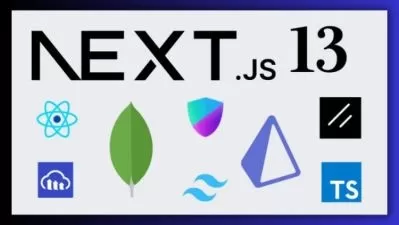Building a News Blog Web App with Next.js and Express
Renan Martins
30:13:47
Description
Develop a full stack news portal website with JavaScript, Nodejs, Nextjs, Sequelize, Postgres, Bootstrap, Markdown
What You'll Learn?
- Building a frontend web application with Nextjs, React Bootstrap
- Building a Nodejs backend web application API that serves JSON using Express
- Being involved in end-to-end full-stack development of a web application
- Leverage Sequelize as ORM and PostgreSQL for database
Who is this for?
More details
DescriptionIn this course IÂ teach you to build a web application that can be used as a news website or a blog portal. It is a very practical course and covers end-to-end development, from the frontend to the backend, including database and leveraging the cloud.
Nextjs, the React framework, is used for the frontend. You get to work with HTML, CSS, Sass, JavaScript, Bootstrap, Markdown.
Express, the serverside web framework, is used for the backend. You get to work with Node.js (serverside JavaScript).
PostgresSQL is used for the database. You get to work with Sequelize for Object-Relational Mapping (ORM).
The course covers building the frontend to display a list of articles, see an article, edit an article. It also teaches you to leverage Markdown as the format to write the articles. React Bootstrap (including Icons) is used as the user interface building blocks. You get to learn about form submission for article data as well as for uploading images.
The course also covers building a backend API that serves data in the JSON format. It covers hooking up your API to a database to store data. You get to learn how to create migrations and models for the Sequelize ORM, that serves as a intermediary between the API and the database.
The course pays special attention to handling image upload and storage in the backend, integrating with an external cloud solution. In particular, Amazon Web Services (AWS) Simple Storage Service (S3) is used to store image files in the cloud. The images are used as a thumbnail for the article and to display in the body of the article.
After taking the course you will get a lot of experience going about fullstack web development and building a web application end to end. You can build upon the knowledge and experience from this course and expand the application to conform your own needs and endeavours.
Who this course is for:
- Web developers looking to build an end-to-end product employing full-stack development
In this course IÂ teach you to build a web application that can be used as a news website or a blog portal. It is a very practical course and covers end-to-end development, from the frontend to the backend, including database and leveraging the cloud.
Nextjs, the React framework, is used for the frontend. You get to work with HTML, CSS, Sass, JavaScript, Bootstrap, Markdown.
Express, the serverside web framework, is used for the backend. You get to work with Node.js (serverside JavaScript).
PostgresSQL is used for the database. You get to work with Sequelize for Object-Relational Mapping (ORM).
The course covers building the frontend to display a list of articles, see an article, edit an article. It also teaches you to leverage Markdown as the format to write the articles. React Bootstrap (including Icons) is used as the user interface building blocks. You get to learn about form submission for article data as well as for uploading images.
The course also covers building a backend API that serves data in the JSON format. It covers hooking up your API to a database to store data. You get to learn how to create migrations and models for the Sequelize ORM, that serves as a intermediary between the API and the database.
The course pays special attention to handling image upload and storage in the backend, integrating with an external cloud solution. In particular, Amazon Web Services (AWS) Simple Storage Service (S3) is used to store image files in the cloud. The images are used as a thumbnail for the article and to display in the body of the article.
After taking the course you will get a lot of experience going about fullstack web development and building a web application end to end. You can build upon the knowledge and experience from this course and expand the application to conform your own needs and endeavours.
Who this course is for:
- Web developers looking to build an end-to-end product employing full-stack development
User Reviews
Rating
Renan Martins
Instructor's Courses
Udemy
View courses Udemy- language english
- Training sessions 167
- duration 30:13:47
- Release Date 2023/04/26











